
 |
|||||
|
|
|||||
|
|
|
|||||
|
|
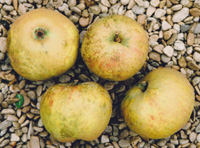 |
THAME MARKET APPLE This second renaming, by us, is the final resting place for an apple that has been the victim of careless ‘identification’. We had formerly named it ‘Sussex Wealden’ under the misapprehension that it was a Sussex apple. David Clennett took some apples to an Apple Day ‘identification’ and was told that it was Buxtead Favourite, a Sussex apple. Later he brought us scionwood and we grafted a new tree, though we lost contact with David. When it fruited it was clear to us that the only published brief description of Buxtead Favourite was not sufficient to identify this apple and was not even in accord with the apple’s appearance. We wrongly assumed that the apple had, at least, come from Sussex to give any reason for such a reckless ‘identification’. We described Sussex Wealden in our last catalogue and asked David Clennett to get in touch, if he read the new catalogue. He did! He was able to correct the history. The original tree was actually growing very close to home in Thame, Oxfordshire, in a back garden to an estate agent’s office, where he then worked. The office was on the High Street, directly opposite the old Thame Market. It is now an Oxfordshire apple and the former description still holds. The medium sized, sometimes rather large apples have skin of pale green, with broken russet in some years and nicely streaked with red. Sometimes ripe in late September and sometimes in mid October, the apples are initially both sweet and sharp, with a very rich flavour. The flesh is very crisp and very juicy. In November and December, the sharpness lessens and the flesh becomes more crumbly, but it is still juicy and very richly flavoured. A really good dessert apple, it can also be cooked but resists softening when young. Later, it keeps its shape completely and is delicious. Ideal for open tarts. Pollination Group 4 |
||
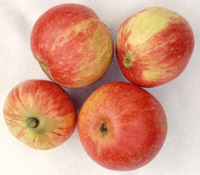 |
THOMAS RIVERS Formerly included in the catalogue as ‘Mainds Costard’, named by others, but since identified as ‘Thomas Rivers’. The apple was brought by Lavinia Mainds of The Old Rectory, Hinton in the Hedges, Northants, to the Apple Day at Sulgrave Manor in 1999. It is a large oblong culinary apple with a pronounced snout at the eye end. The green skin, with occasional russeting, turns yellow and develops red streaks sometimes extending over large areas and joining up. With a pleasant flavour, it is ripe and crisp in late September and does not keep beyond December. A rich culinary apple becoming sweeter at full ripeness. Bred by Rivers Nursery at Sawbridgeworth, Herts, before 1890, from American Mother. It was first called Rivers’ Codlin. Pollination Group 5 |
|||
THOMAS
TIPPING We recently returned to the large old orchard, attached
to the 17th century thatched house, which we had investigated many years
earlier with the late Mrs Story, at the oldest part of Little Ickford,
just in Buckinghamshire but very close to Oxfordshire. Mrs Story’s
daughters, Clare and Jo, met us there and we were able to offer some variety
names revealed by dna profiling. Three trees had unmatched dna and have
now been included in this catalogue. Strawberry Queen and Ickford Russet
are the others. This tree was a bit of a mystery but clearly very old,
given its location, size at ground level and appearance. Whether it regrew
from an old decayed trunk or whether it grew from the rootstock of a long
gone trunk cannot now be known. It is a small bittersharp cider apple,
ripe in late September and still in good condition at the end of November.
Rounded, green turning yellow with an occasional orange blush and lightly
russeted, It is not pleasant, eaten raw but would undoubtedly make a good
cider. Clare and Jo have decided to call it “Thomas Tipping”
for the connection with old Ickford they describe. In the 16th century,
the Bisham Priory lands passed to Thomas Tipping who, from 1585, held
the Manors of Great and Little Ickford. He died in either 1595 or 1601
and is commemorated by a large monument in the parish church. Thomas's
great-grandson Sir Thomas Tipping, who inherited the estate in 1627, was
a moderate Parliamentarian in the English Civil War. Clare and Jo have
wittily suggested that any cider made from it would surely have to be
called Thomas Tipping’s Tipple! Pollination Group 4 |
||||
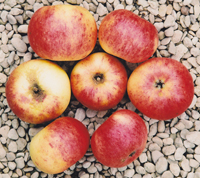 |
THORLE
PIPPIN An old Scottish apple, first recorded in 1802 when Forsyth
described it as ‘a pretty flat early Apple of great beauty’.
It has also been known as Whorle Pippin. Hogg (1884) said that it was
grown in almost every garden and orchard in Scotland. It has long been
popular in the south as a refreshing, crisp, juicy and sweet eating apple,
ripe in August, as well as a cider ‘sweet’. The apples do
not store for long, but tend to ripen over a period, extending the season
into late September, in the south. Pollination Group 3 |
|||
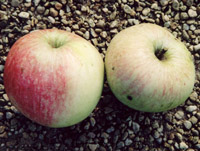 |
THORPE’S
PEACH A mid-season dessert apple raised at Brackley, Northamptonshire,
by Miss Goodwin at E.J. Thorpe’s Nursery towards the end of the
19th century. It was introduced in 1927 and first exhibited in 1929. Medium
to large sized fruit with a scarlet flush and a greyish bloom, hence the
name. The flesh is very crisp, very juicy and very sweet. When cut, the
apple does not discolour at all, not even overnight, so it is very useful
for salads. The flavour is pleasing and refreshing, but not intense. Ripe
in mid September, keeping until October. Trees have a spreading habit.
Pollination Group 4 |
|||
TICKFORD
BEAUTY A couple of decades ago, we were taken around Newport
Pagnell in the excellent company of Christine Nichols, much interested
in the history of the town and its fruits, to investigate several apple
and pear trees planted around the town. We took scions and planted them
here, but most were revealed to be known varieties by dna tests. One that
was unmatched was growing in a field over a tall hedge on the outskirts
of the town on the London Road and we were unable to see the trunk or
estimate its age, but able to reach the abundant overhanging crop from
the verge. The medium sized apples were ripe in October and beautifully
streaked with red, the flesh being crisp, very juicy, sweet and with a
rich flavour. They are still in good condition at the end of the year.
Chris asked a friend, Di, about naming the apple and she suggested Tickford
Beauty, a name that Chris enthusiastically embraced in view of the local
history. The tree lies on the road to the famous Tickford Bridge, believed
to be the first Iron Bridge, which itself takes its name from the old
Tickford Priory, which goes back centuries. The Newport Pagnell Historical
Society now know of the tree and the new name. Pollination Group 4 |
||||
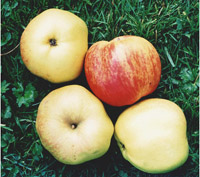 |
TILLINGTON
COURT A dual purpose apple first noted at the Apple and Pear
Conference of 1934, held at RHS Wisley, but believed old before then.
It was said to have been raised around Burghill, close to Tillington Court,
Herefordshire, and Taylor says it was often found around Tillington Court.
The apples are conical, ribbed, irregularly shaped, and with the yellow
skin largely covered with a scarlet flush and streaks. When fully ripe
in October, the flesh is yellow, juicy, sweet and rich but just a little
sharp. When cooked it breaks down quickly and would mash. The flavour
is rich, tangy and lemony. The acidity is high but most would not need
sugar added. A late season apple, keeping to January. T*. Pollination
Group 5 |
|||
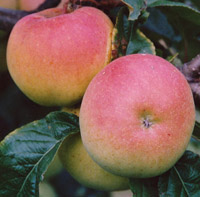 |
TINSLEY
QUINCE An apple of uncertain age, first noted when it entered
the National Fruit Trials in 1942. It was sent by R. Fairman of Crawley,
in Sussex. An attractive dessert apple of medium to large size, ripe in
late October and storing until December. It is flattened round, ribbed
at the eye but barely on the body. The skin is pale yellow dotted with
russet and often with an orange/pink flush. The flesh is yellowish, firm,
sweet and nicely flavoured, though not strongly of quince. Trees have
a spreading habit. Pollination Group 3 |
|||
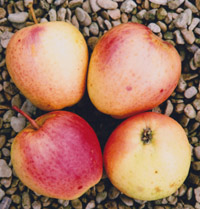 |
TIPPETTS
Triple purpose but mainly used for cooking. Probably 19th century or earlier
in origin. Large, quite long fruit, irregular in shape, with green skin
ripening to pale yellow, sometimes with a warm blush and a few stripes.
By early November it is good to eat raw, being sweet and juicy, with the
juice sometimes flowing out, and the acidity mild. It has a hint of toffee.
When cooked, it softens slowly but completely while keeping its shape.
The flavour is rich and now slightly more acid but no added sugar is needed
though some might prefer it. Late season, it will store to January. Pollination
Group 6 |
|||
| TOLMAN SWEET In 1630 Thomas Tolman left Salcombe Regis in Devon to set sail for a new life in America. He settled at Dorchester, Suffolk County, Massachusetts and was the single source of the many thousands of Tolmans now in America. Our own family history goes back far enough and so close to Salcombe Regis and nearby Seaton that it must be certain that Thomas Tolman was a relative of ours. At some point Tolman Sweet became known in Dorchester, Massachusetts, but there is no evidence of when. Perhaps it was brought from Devon in 1630, or perhaps a descendent of Thomas Tolman found it or bred it. The connection is enough for us to want to have it here and offer it to anyone interested. It is, after all, one of the earliest and most historically respected apples in America. First recorded in America by Thatcher, in 1822 it was, even then, thought old. It was said to have spread from Rhode Island (the starting point for immigrants) westwards with the settlers. It was once widely grown in the northern USA and northern Midwest as well as Canada, and valued for its hardiness. For that reason it was also widely used as a rootstock. Medium sized, round apples, yellow sometimes with a reddish blush, fine grained, firm, sweet and rich as a dessert apple, and also used for pickling, boiling and baking, as well as for cider. A late season apple which lasts into the New Year. Pollination Group 6 | ||||
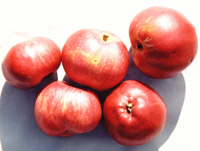 |
TOM
PUTT A very old English mid-season eating apple, an underestimated
cooking apple which was also much used for cider making. Raised towards
the end of the 18th century by the Reverend Tom Putt, or by his uncle
of the same name, and brought to the vicarage at Trent, nr. Sherborne,
Dorset. Two seemingly distinct apples have been accorded this name, a
Somerset variety and a Herefordshire variety. This is the Somerset one
with conical fruit, covered in long, broad stripes of vivid red, sometimes
completely red. Firm flesh when young, developing a complex sweet flavour.
When cooked, the flavour is rich and sweet. The trees are vigorous, low,
and very spreading. T*. Pollination Group 4 |
|||
|
||||